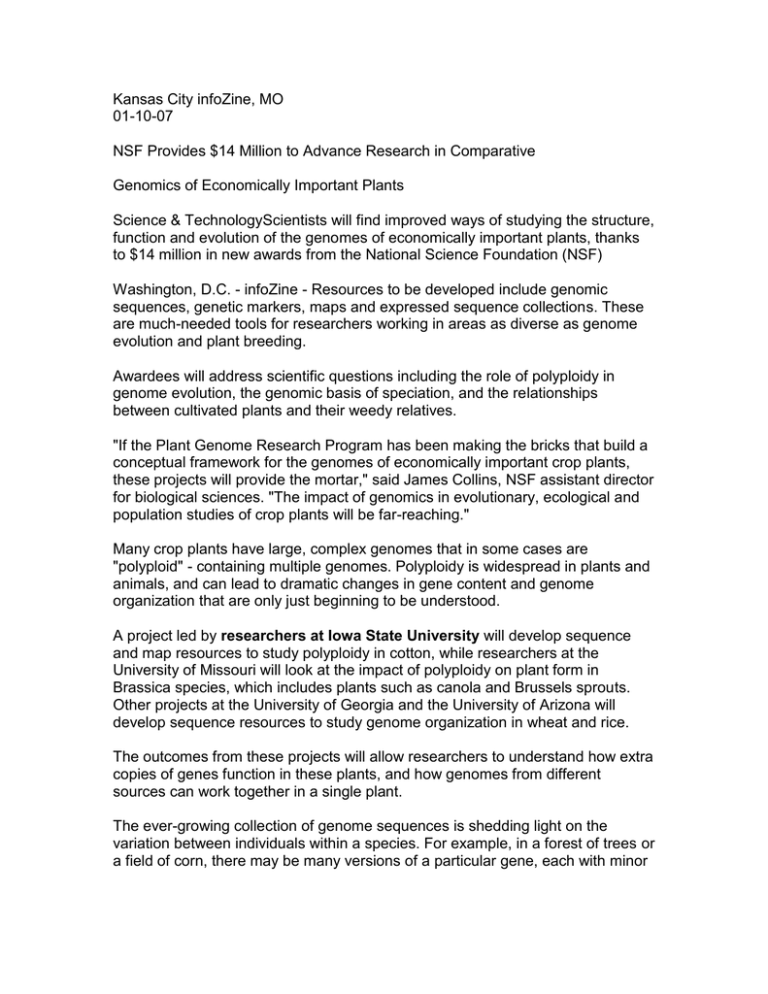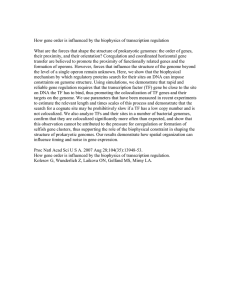Kansas City infoZine, MO 01-10-07
advertisement

Kansas City infoZine, MO 01-10-07 NSF Provides $14 Million to Advance Research in Comparative Genomics of Economically Important Plants Science & TechnologyScientists will find improved ways of studying the structure, function and evolution of the genomes of economically important plants, thanks to $14 million in new awards from the National Science Foundation (NSF) Washington, D.C. - infoZine - Resources to be developed include genomic sequences, genetic markers, maps and expressed sequence collections. These are much-needed tools for researchers working in areas as diverse as genome evolution and plant breeding. Awardees will address scientific questions including the role of polyploidy in genome evolution, the genomic basis of speciation, and the relationships between cultivated plants and their weedy relatives. "If the Plant Genome Research Program has been making the bricks that build a conceptual framework for the genomes of economically important crop plants, these projects will provide the mortar," said James Collins, NSF assistant director for biological sciences. "The impact of genomics in evolutionary, ecological and population studies of crop plants will be far-reaching." Many crop plants have large, complex genomes that in some cases are "polyploid" - containing multiple genomes. Polyploidy is widespread in plants and animals, and can lead to dramatic changes in gene content and genome organization that are only just beginning to be understood. A project led by researchers at Iowa State University will develop sequence and map resources to study polyploidy in cotton, while researchers at the University of Missouri will look at the impact of polyploidy on plant form in Brassica species, which includes plants such as canola and Brussels sprouts. Other projects at the University of Georgia and the University of Arizona will develop sequence resources to study genome organization in wheat and rice. The outcomes from these projects will allow researchers to understand how extra copies of genes function in these plants, and how genomes from different sources can work together in a single plant. The ever-growing collection of genome sequences is shedding light on the variation between individuals within a species. For example, in a forest of trees or a field of corn, there may be many versions of a particular gene, each with minor sequence differences. These sequence differences can sometimes have dramatic effects on growth and development. Projects based at the University of California at Davis and Cornell University will catalog variants in pine trees and in maize, respectively, to allow researchers to link genetic variation with changes in gene function. This information could have applications in plant breeding. More than half of the world's most cultivated crops have relatives that are invasive weeds, competing with the crop for nutrients and water and leading to reduced yields. One example is red rice, a weedy form of rice that reduces the yields of cultivated rice by as much as 80 percent and contaminating harvests with its small red-coated grains. A project led by researchers at Washington University St. Louis will examine the regions of the red rice genome associated with weediness to find out whether it originated from the domesticated crop or if it was introduced as a weed from Asia. A related project led by investigators at Michigan State University will investigate differences in gene expression in weedy and cultivated radishes to uncover which genes are associated with invasiveness.The outcomes of these projects could lead to a great understanding of how plants become weedy and invasive, and yield possible avenues for better selective control of weeds, scientists believe. "The outcomes of this new program will tie together studies of the evolution of gene structure, function and regulation across the whole plant kingdom," said Collins.







